Why my Panasonic Heat Pump system does not work?
- LLaura WhitakerAug 7, 2025
The most probable cause is that the circuit breaker has tripped or activated.
Why my Panasonic Heat Pump system does not work?
The most probable cause is that the circuit breaker has tripped or activated.
Why Panasonic WH-ADC0912K6E5 outdoor unit does not operate?
The outdoor unit may not operate due to the system's protection control when the outdoor temperature is outside of the specified operating range.
How to fix a noisy Panasonic WH-ADC0912K6E5 Heat Pump during operation?
If your Panasonic Heat Pump is noisy, it might be due to the outdoor or indoor unit being installed at an incline. Ensure the cover is properly closed.
General safety warnings and precautions for indoor and outdoor units.
Safety guidelines related to the unit's power supply connection and usage.
Specific cautions for the indoor unit, outdoor unit, and remote controller.
Important safety information and precautions when handling R32 refrigerant.
Further safety instructions including ventilation and personnel training requirements.
Safety measures for system installation and servicing procedures.
Safety protocols for work, refrigerant leak checks, and fire extinguisher availability.
Precautions regarding ignition sources, ventilation, and refrigerating equipment checks.
Safety checks for electrical devices and procedures for repairing sealed components.
Safety guidelines for intrinsically safe components, cabling, and leak detection methods.
Procedures and safety measures for refrigerant removal, evacuation, and charging.
Safety procedures for decommissioning the system and proper labelling requirements.
Safe practices and procedures for refrigerant recovery during servicing or decommissioning.
Explanation of the remote controller's buttons and display indicators.
Details on using the cross key and enter buttons for navigation and selection.
Description of various display modes, operation icons, and temperature zone indicators.
Steps to select the operating language for the remote controller during initial setup.
Instructions for setting the date and time on the remote controller.
How to display and navigate through the Quick Menu options.
Overview of available functions within the Quick Menu for quick adjustments.
Instructions on using Force DHW and Powerful mode via the Quick Menu.
Guide to operating the system quietly and setting quiet timers.
Instructions for forcing the heater to turn on via the Quick Menu.
How to set up, edit, or delete weekly timer patterns for operation.
Using Quick Menu for force defrost, error reset, and remote control lock/unlock.
Configuration for weekly and holiday timers.
Detailed steps for setting up quiet operation timers.
Settings for quiet priority, heaters, sterilization, and DHW modes.
Accessing system information, energy monitoring, and error history.
Customizing remote control, touch sound, display contrast, and clock format.
Setting display language, managing passwords, and configuring service contact information.
Connecting optional PCB and configuring system zones and sensors.
Adjusting heater power and activating anti-freezing protection.
Configuring DHW, buffer tank, base pan heater, and external sensor settings.
Detailed settings for bivalent connection, including control patterns and temperature thresholds.
Configuring bivalent system using SG ready or smart control patterns.
Setting electricity and boiler prices for optimizing bivalent operation costs.
Configuring seasonal schedules and operational patterns for bivalent systems.
Configuring external switches and solar connection for system functionality.
Settings for solar connection, error signals, demand control, SG ready, and circulation liquid.
Settings for heat-cool modes, force heater, defrost, pump flow, DHW defrost, and heating control.
Setting up external meters for energy generation and consumption monitoring.
Enabling or disabling the operation of the electrical anode.
Configuring water and outdoor temperatures for heating operation.
Detailed settings for water temperatures, delay times, and cooling parameters.
Setting automatic switching between heating and cooling modes based on outdoor temperature.
Configuration for tank floor operation time, heat-up time, and sterilization.
Setting maximum pump speed and configuring pump down operation.
Using the dry concrete function for construction purposes.
Setting up contact information for service engineers or installers.
Instructions for cleaning the indoor/outdoor units and performing regular checks.
Maintenance for the water filter and checking water pressure.
Information on safety relief valves and conditions requiring dealer consultation.
Procedures for filling, venting, and user/dealer maintenance responsibilities.
Common operational sounds or delays that do not signify a malfunction.
Essential checks to perform before calling for servicing or troubleshooting.
List and explanation of error codes displayed on the remote controller.
Information on using the network adaptor and remote operation safety.
Guidelines for the collection and disposal of old electrical and electronic equipment.
General safety warnings and precautions for indoor and outdoor units.
Safety guidelines related to the unit's power supply connection and usage.
Specific cautions for the indoor unit, outdoor unit, and remote controller.
Important safety information and precautions when handling R32 refrigerant.
Further safety instructions including ventilation and personnel training requirements.
Safety measures for system installation and servicing procedures.
Safety protocols for work, refrigerant leak checks, and fire extinguisher availability.
Precautions regarding ignition sources, ventilation, and refrigerating equipment checks.
Safety checks for electrical devices and procedures for repairing sealed components.
Safety guidelines for intrinsically safe components, cabling, and leak detection methods.
Procedures and safety measures for refrigerant removal, evacuation, and charging.
Safety procedures for decommissioning the system and proper labelling requirements.
Safe practices and procedures for refrigerant recovery during servicing or decommissioning.
Explanation of the remote controller's buttons and display indicators.
Details on using the cross key and enter buttons for navigation and selection.
Description of various display modes, operation icons, and temperature zone indicators.
Steps to select the operating language for the remote controller during initial setup.
Instructions for setting the date and time on the remote controller.
How to display and navigate through the Quick Menu options.
Overview of available functions within the Quick Menu for quick adjustments.
Instructions on using Force DHW and Powerful mode via the Quick Menu.
Guide to operating the system quietly and setting quiet timers.
Instructions for forcing the heater to turn on via the Quick Menu.
How to set up, edit, or delete weekly timer patterns for operation.
Using Quick Menu for force defrost, error reset, and remote control lock/unlock.
Configuration for weekly and holiday timers.
Detailed steps for setting up quiet operation timers.
Settings for quiet priority, heaters, sterilization, and DHW modes.
Accessing system information, energy monitoring, and error history.
Customizing remote control, touch sound, display contrast, and clock format.
Setting display language, managing passwords, and configuring service contact information.
Connecting optional PCB and configuring system zones and sensors.
Adjusting heater power and activating anti-freezing protection.
Configuring DHW, buffer tank, base pan heater, and external sensor settings.
Detailed settings for bivalent connection, including control patterns and temperature thresholds.
Configuring bivalent system using SG ready or smart control patterns.
Setting electricity and boiler prices for optimizing bivalent operation costs.
Configuring seasonal schedules and operational patterns for bivalent systems.
Configuring external switches and solar connection for system functionality.
Settings for solar connection, error signals, demand control, SG ready, and circulation liquid.
Settings for heat-cool modes, force heater, defrost, pump flow, DHW defrost, and heating control.
Setting up external meters for energy generation and consumption monitoring.
Enabling or disabling the operation of the electrical anode.
Configuring water and outdoor temperatures for heating operation.
Detailed settings for water temperatures, delay times, and cooling parameters.
Setting automatic switching between heating and cooling modes based on outdoor temperature.
Configuration for tank floor operation time, heat-up time, and sterilization.
Setting maximum pump speed and configuring pump down operation.
Using the dry concrete function for construction purposes.
Setting up contact information for service engineers or installers.
Instructions for cleaning the indoor/outdoor units and performing regular checks.
Maintenance for the water filter and checking water pressure.
Information on safety relief valves and conditions requiring dealer consultation.
Procedures for filling, venting, and user/dealer maintenance responsibilities.
Common operational sounds or delays that do not signify a malfunction.
Essential checks to perform before calling for servicing or troubleshooting.
List and explanation of error codes displayed on the remote controller.
Information on using the network adaptor and remote operation safety.
Guidelines for the collection and disposal of old electrical and electronic equipment.
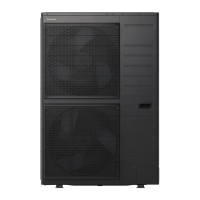
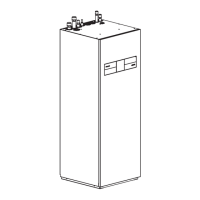

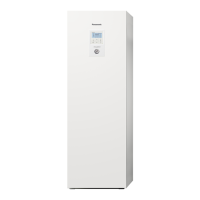

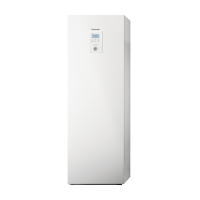
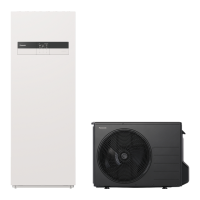
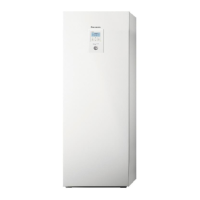

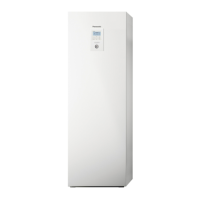

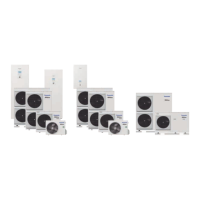
